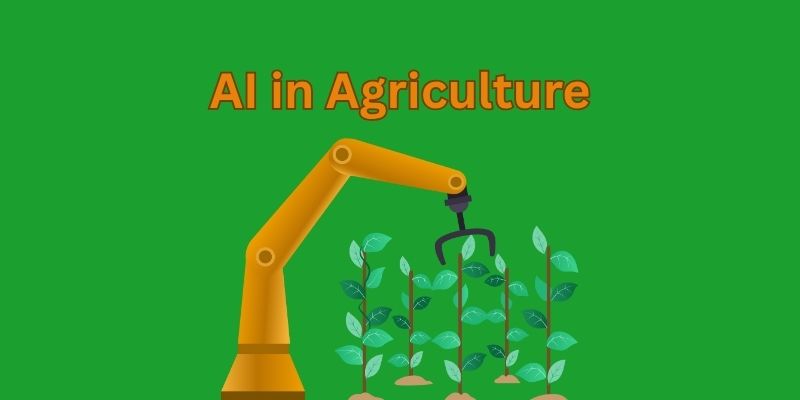How Is AI Used in Agriculture. The Rise of Intelligent Farming in a Digital World
Published: 22 Jun 2025
At first, it sounds strange — artificial intelligence… on a farm? Isn’t AI something you find in high-tech labs or self-driving cars, not in muddy fields and among crops? How can machines understand plants, soil, or livestock the way a farmer does with years of experience? It’s hard to imagine technology replacing intuition, tradition, and the human touch in agriculture. Yet quietly, and almost invisibly, AI is doing something surprising: it’s not replacing farmers — it’s empowering them. From predicting crop diseases before they spread to saving water in drought-prone areas, AI is becoming the partner farmers never knew they needed.
So, guys, without wasting time, let’s jump into the article to learn the How Is AI Used in Agriculture? The Rise of Intelligent Farming in a Digital World
1. Why AI in Agriculture Feels Confusing
“Farming with artificial intelligence? Isn’t that just for Silicon Valley?”
At first glance, it sounds strange — machines making decisions on a farm? But in truth, AI is revolutionizing agriculture in quiet, powerful ways. It doesn’t replace the farmer — it amplifies their knowledge, helps them make smarter choices, and supports them where nature once left them helpless. From predicting rain to spotting pests before they spread, AI gives farmers control they’ve never had before.

2. What Is Agricultural AI?
- Artificial Intelligence in agriculture uses data, machine learning, and automation to make accurate decisions in real time.
- It helps analyze huge amounts of information like soil conditions, crop growth, weather trends, pest movements, and more.
- With AI, farming becomes predictive, not reactive — helping farmers act early, save resources, and improve results.
- It’s not just about tech — it’s about survival, efficiency, and protecting our food systems for the future.
3. How AI Is Used in Agriculture
Farming isn’t just about tractors and soil anymore — it’s about data, decisions, and smart technology. Artificial Intelligence (AI) is now helping farmers grow healthier crops, save water, and protect their land with more accuracy than ever before.
a. Smart Crop Monitoring
- AI combines drone imagery, satellite data, and computer vision to scan crop health.
- Detects early signs of:
- Pests or insect infestations
- Fungal infections
- Nutrient deficiencies
- Drought stress or overwatering
- Sends real-time alerts to farmers for quick action.
- Emotional Insight: No more guesswork. AI acts like a protective shield — watching over crops like a silent, faithful partner.
b. AI-Based Irrigation
- Integrates soil moisture sensors, crop needs, and weather forecasts.
- Waters only when and where it’s truly needed.
- Cuts water usage by up to 50%, especially in water-scarce areas.
- Prevents root rot, waterlogging, and drought damage.
c. Soil Health Management
- AI tools analyze soil samples for:
- NPK levels (Nitrogen, Phosphorus, Potassium)
- pH levels and organic content
- Toxic chemical buildup
- Recommends:
- The best crop choices
- Organic fertilizers
- Rotational plans to restore soil health
d. Predictive Analytics
- AI forecasts:
- Crop yield estimates
- Market demand and pricing
- Weather extremes
- Pest and disease outbreaks
- Guides farmers in making profitable, timely decisions.
- Emotional Insight: For generations, farming was a gamble. Now, AI brings clarity and calm into a profession that’s always been uncertain.
e. Livestock Monitoring
- Facial recognition and motion sensors track:
- Feeding habits
- Body temperature
- Disease symptoms
- Reproductive cycles
- AI alerts farmers when animals are sick — before symptoms are visible.
- Leads to healthier animals and higher meat/milk yields.
f. AI Apps and Chatbots
- Voice-based mobile apps available in local languages.
- Provide:
- Crop and fertilizer advice
- Real-time pest control solutions
- Weather alerts
- Market price comparisons
- Even small farmers with no formal education can now access scientific guidance daily.
g. AI Pest Prediction
- Machine learning detects early pest behavior using:
- Camera traps
- Satellite maps
- Historic outbreak data
- Sends early warnings to prevent outbreaks.
- Reduces dependency on chemical sprays.
- Emotional Insight: Farmers no longer watch their crops be destroyed helplessly. AI gives back power and protection.
h. Climate-Smart Farming
- AI tracks long-term climate changes and suggests:
- Heat/drought-resistant crops
- Modified planting dates
- Soil water retention techniques
- Supports sustainable farming methods that protect the environment.
- Emotional Insight: In the face of global climate uncertainty, AI offers not just tools — it offers hope.
4. The Real Benefits of AI in Agriculture
- Increases productivity even on small plots
- Reduces waste of water, seeds, chemicals
- Minimizes risks and financial losses
- Helps adapt to climate change
- Empowers both large and small-scale farmers
- Makes farming smarter, safer, and more profitable
5. The Challenges Farmers Face with AI
- High startup cost for equipment
- Lack of awareness or digital literacy
- Poor internet connectivity in rural areas
- Fear of replacing human jobs
- Trust-building is still ongoing
FAQs about How Is AI Used in Agriculture?
Here are some of the most frequently asked questions about How Is AI Used in Agriculture? The Rise of Intelligent Farming in a Digital World
AI uses cameras, sensors, and drones to spot early signs of plant stress, pests, or disease. It analyzes patterns in color, shape, or growth that may not be visible to the naked eye.
While some AI tools can be costly, many apps and services are now affordable or even free. Governments and agri-tech startups are also offering support to help small farmers access these tools.
Yes! AI-based irrigation systems use soil and weather data to water only when and where it’s needed. This helps you save water and avoid over- or under-watering your plants.
AI analyzes soil samples to check for nutrients, pH levels, or chemical buildup. It then recommends how to fix the issues using the right fertilizers or crop rotation plans.
Absolutely. Many AI-powered apps are available in local languages and even use voice commands. They’re designed to be simple, so anyone can use them, even without reading or writing.
6. Final Emotional Takeaway
Artificial Intelligence is not here to replace the farmer.
It’s here to protect the farmer.
To give them tools, not stress. To bring back control, not confusion.
In a world where one bad season can break a family, AI offers a future worth farming for — one where crops are healthier, land is respected, and every farmer has the wisdom of a thousand seasons in their pocket.

- Be Respectful
- Stay Relevant
- Stay Positive
- True Feedback
- Encourage Discussion
- Avoid Spamming
- No Fake News
- Don't Copy-Paste
- No Personal Attacks

- Be Respectful
- Stay Relevant
- Stay Positive
- True Feedback
- Encourage Discussion
- Avoid Spamming
- No Fake News
- Don't Copy-Paste
- No Personal Attacks





